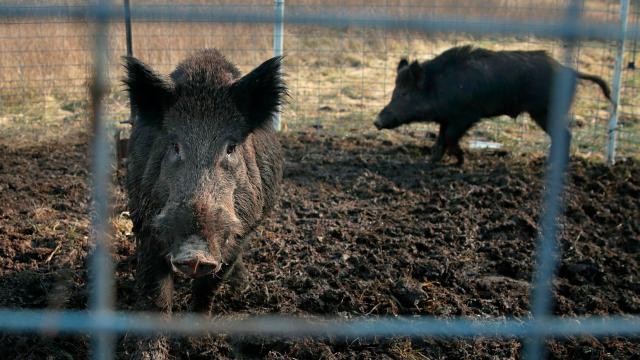Incredibly intelligent. Jaw-droppingly massive. Able to elude predators by burrowing for hours under the snow in freezing temperatures.
They may sound villainous creatures in an apocalyptic movie, but they’re actually more closely related to Babe. A new breed of wild hog is migrating south from Canada and could pose new problems for the U.S.’s burgeoning — and problematic — pig population.
While pigs are not native to North America, they’ve been here for quite a while: The first documented pigs arrived in the States in 1539 on a boat that landed in Florida. The population of wild pigs has exploded over the past two decades, thanks in part to people releasing pigs into new areas to hunt them, and there’s now an estimated 6 million to 7 million in the continental U.S., ranging over 48 states; in 2000, they were present in just 27.
Pigs may sound like a loveable pest, but these hogs can devastate native ecosystems, and they tear up farmland and crops, causing billions of dollars in damage.
“Wild hogs feed on anything,” Ryan Brook, who leads the University of Saskatchewan’s Canadian Wild Pig Research Project, told Field & Stream last month. “They gobble up tons and tons of goslings and ducklings in the spring. They can take down a whitetail deer, even an adult. Originally, it was like ‘wow, this is something we can hunt.’ But it’s become clear that they’re threatening our whitetail deer, elk, and especially, waterfowl. Not to mention the crop damage. The downsides outweigh any benefit wild hogs may have as a huntable species.”
The presence of too many pigs worldwide is also wreaking havoc on the climate. Wild hogs love to rummage around in the dirt in search of food, and disturbing all that soil can release the carbon stored inside. A study published last year estimated that wild hogs cause the release of some 5.37 million tons of carbon dioxide each year. Hogs can also spread diseases that can infect humans, including E. coli, salmonella, and hepatitis.
The U.S.’s pig problem might be old, but our neighbours to the north have less experience with managing these wild hogs. “We didn’t have any here until the early 1980s,” Brook told Field and Stream. “There was a big push to diversify agriculture with species like wild boars and ostriches. Wild boars were brought in from Europe to be raised on farms across Canada.”
Once they arrived in Canada, farmers crossbred these boars with domestic pigs. When the market for boar meat dried up in Canada in the early 2000s, some of these new big pigs roamed free or escaped from their enclosures. Pigs have an impressive breeding rate — some research suggests that up to 75% of the population needs to be eliminated to effectively eradicate it, thanks to how good they are at reproducing — and the Canadian wild pig population skyrocketed right around the same time as the U.S.’s did, spreading rapidly to roam wild over 1,605,794 by 2021.
The pigs are working with a new superpower, helped along by that crossbreeding: They’re bigger than their ancestors. People have seen pigs as big as 661 pounds (300 kilograms) in the wild, according to the Guardian. Being so large has helped them to withstand frigid Canadian winters. The pigs are able to survive freezing winds and tunnel under the snow in cattail marshes to make insulated dens when it gets particularly cold.
“All the experts said at that time: ‘Well, no worries. If a wild pig or a wild boar ever escaped from a farm, there’s no way it would survive a western Canadian winter. It would just freeze to death,’” Brook told the Guardian earlier this week. “Well, it turns out that being big is a huge advantage to surviving in the cold.”
The Canadian super pigs are migrating south at the exact wrong time. The U.S. has been struggling for years with controlling its pig population, and new super pigs coming down from the north could only strengthen the numbers of pigs in the wild.
“Probably as late as maybe 2010 to 2012, there was probably a reasonable chance of finding and removing them,” Brook told the Guardian. “But now, they’re so widespread, and so abundant, that certainly as late as 2018 or 19 I stopped saying that eradication was possible. They’re just so established.”
